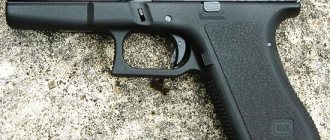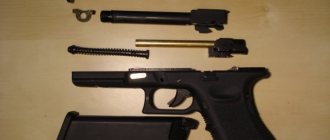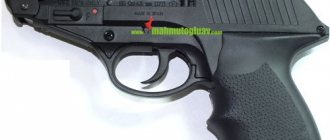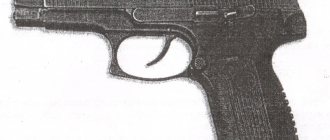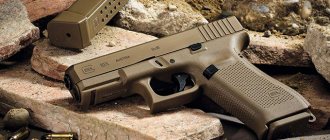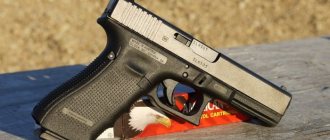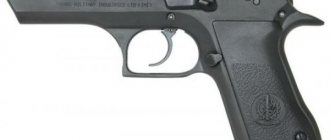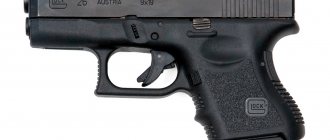Glock 21 Gen 4
This rifle unit is a fourth-generation Glock 21 model. The pistol grip has a separate replaceable part, also called the “back plate.” This name is due to the fact that it is located at the back of the handle. The weapon is also equipped with two additional parts, medium (M) and large (L), with which the owner can optionally replace the standard Shot frame. This is used if the shooter has long fingers. With the M part installed, the distance to the trigger increases by 0.2 cm, and with L – by 0.4. Replacement is carried out by removing the mounting screw with a special tool that comes with the gun. Glock 21 Gen 4 with larger, more comfortable magazine catches. The pistol is designed for left-handed use. The owner only needs to move the button to the side he needs. For this reason, the magazines of the fourth generation Austrian pistols are equipped with a second window located on the right side, into which the latch tooth enters. Clips from previous generation shooting models will only fit Gen 4 if the button is located on the left side of the pistol.
Glock 21 pistol
| Early Glock 21 |
The brainchild gave rise to one of the most successful stories in the pistol industry.
Glock pistols sold well in both civilian and specialty markets. Glock 21
But for many shooters, especially in the United States, handguns fall into two categories: .45 caliber and the rest. In this regard, in 1990, she created the Glock 21 pistol chambered for the large-caliber .45 ACP cartridge. In 1991, mass production of these weapons began.
The Glock 21, along with the large-caliber Glock 20 pistols chambered for 10 mm Auto and the Glock 22 chambered for .40 S&W, opened the line of second-generation Glock family pistols.
The Glock 21 pistol itself is another modification of the base model Glock 17, with which it is completely identical in design. However, changes were made to the new pistol due to the use of the powerful .45 ACP cartridge in the Glock 21. The .45 ACP cartridge has served as military and police ammunition for many years, and is also an excellent choice for self-defense weapons. A heavy (usually 14.8 g) bullet has a relatively low speed and has a great stopping effect.
The Glock 21's use of the .45 ACP cartridge makes the pistol slightly longer and wider than the Glock 17, but even so, the pistols have 50% parts interchangeability. The Glock 21 also received a reinforced locking block - a second transverse axis was added.
| Early Glock 21 |
Glock 21 incomplete disassembly
In fact, the Glock 21 is a Glock 20 pistol, but of a larger caliber. The overall dimensions of the Glock 21 and Glock 20 are completely similar. In connection with the use of the .45 ACP cartridge, the barrel profile was changed, which became octagonal with a right-hand thread and a pitch of 400 mm, and the magazine capacity was reduced to 13 rounds.
The Glock 21 pistol, like the previous large-caliber model Glock 20, is presented in 3 versions: - Glock 21 - basic model. — Glock 21C – differs from the Glock 21 only in the integrated barrel flip compensator. The compensator is made in the form of a group of holes in the upper muzzle of the barrel, which correspond to cutouts in the bolt housing next to the front sight. The abbreviation "C" in the pistol's name stands for "Compensated". - Glock 21SF - differs from the Glock 21 only in a narrower handle, obtained by shifting the rear part forward, especially for ease of holding by shooters with a small hand. The abbreviation "SF" in the pistol's name stands for "Short Frame".
| Glock 21 with used ammunition |
Glock 21
The Glock 21 automatic, as in previous models, works due to the recoil of the barrel during its short stroke. The barrel bore is locked by the upper protrusion of the barrel entering the window of the bolt casing. The barrel bore is unlocked by lowering its breech down using the lower breech boss and axis during recoil of the barrel.
The U-shaped shutter casing is made of steel using high-precision casting and subjected to special treatment to increase corrosion and wear resistance.
The barrel, as well as the bolt casing, is treated with a special tenifer coating. The barrel profile is octagonal with a right-hand rifling and a pitch of 400 mm.
The pistol has a striker-fired trigger mechanism, the so-called “Safe Action”, with 3 automatic safeties, including one on the trigger. A feature of the “safe action” trigger is that during the reloading cycle of the pistol, the firing pin is only partially cocked, while it is blocked using an automatic safety lock. The firing pin is re-cocked only when the trigger is pressed, while the firing pin remains blocked from moving forward until the trigger is fully pulled. Thus, it is possible to achieve a uniform force on the trigger from the first to the last shot, which has a positive effect on shooting accuracy. The standard trigger force is 2.5 kg.
| Glock 21 |
magazines used in the Glock 21
The frame of the pistol, together with the handle and trigger guard, is made of high-strength polymer material (plastic) of the monocoque type. The guide frames along which the steel shutter-casing moves are reinforced with steel inserts.
Early releases of the pistol had handles with flat cheeks and grooved front and rear surfaces. Pistols of later releases have grooves for fingers on the front side of the handle and small “shelves” for the thumb on their sides, and under the barrel there are guides for attaching various accessories (laser pointer, flashlight, etc.).
Open-type sighting devices are mounted on the flat upper surface of the bolt casing and include a front sight with a sight installed in dovetail grooves. The front sight is equipped with a luminous dot, and the rectangular slot of the sight is framed by a luminous frame.
The weapon is fed with ammunition from a standard detachable box magazine with a double-row arrangement of 13 rounds in a checkerboard pattern.
| Glock 21SF |
| Glock 21 | |
| Caliber, mm | .45 ACP |
| Length, mm | 193 |
| Barrel length, mm | 117 |
| Height with magazine, mm | 139 |
| Width, mm | 32.5 |
| Weight (without magazine / equipped), kg | 0.745 / 1.085 |
| Magazine weight (without cartridges / loaded), kg | 0.088 / 0.340 |
| Store, count. cartridges | 13 |
| Sighting range, m | 50 |
All metal parts of the Glock 21 model pistol are processed using Tennifer technology. As a result of this treatment, the surface to a depth of 0.05 mm acquires a hardness of about 69 Rockwell units (for comparison, the hardness of industrial diamonds is 71-72).
Since the Glock 21 pistol was created specifically taking into account the characteristics of the cartridge used, its reliability was the same as that of other models of the Glock family.
At one time, the Glock 21 was adopted by a number of police departments that used the .45 ACP as a service cartridge, but needed a more modern pistol.
Compared to the 7- or 8-round magazines of other .45 caliber pistols, it provided greater firepower comparable to 9 mm weapons. Although the number of rounds alone cannot win a fight, the ability to fire 5-6 extra shots without having to reload is very attractive to a person who trusts his weapon with his life. Glock 21 and Glock 21SF
Also, according to some sources, the pistol was adopted by US combat swimmers, although under water it is absolutely useless and even gets in the way.
In general, the Model 21, like other Glock pistols, began to enjoy deserved popularity.
In addition, the Glock 21 turned out to be an excellent platform for testing new ammunition. Created on the basis of the .45 ACP, the .400 Cog-Bon cartridge has ballistics comparable to the 10 mm Auto, but due to the large volume of its bottle case, less pressure occurs when fired, i.e. shooting becomes more comfortable. To use a new cartridge in the Glock 21, simply replace the barrel, while maintaining the reliability of the weapon.
| Glock 21C |
Pistol OTs-21 Malysh cartridge caliber 9 mm. Device
OTs-21 “Malysh” is a Russian self-loading small-sized pistol, developed by order of the Ministry of Internal Affairs. It was developed at TsKIB SOO by Yuri Ivanovich Berezin in the mid-90s. The designer used a 9-mm PM cartridge as ammunition - despite this, the dimensions of the OTs-21 are quite comparable to the 6.35 mm TK.
In addition, the “Baby” has no protruding parts, and its width is only 2 centimeters. This was achieved by eliminating the safety devices and making the trigger, front sight and rear sight hidden. The Malysh’s automatic system works due to the recoil of the free bolt, the center of mass of which is located noticeably closer to the handle than, for example, that of the PM and, as a result, the overturning moment when firing is not so significant.
Ammunition is fed from a single-stack, 5-round box magazine. Like most other types of domestic small arms, the “Malysh” is easy to use, and its partial disassembly is carried out without the use of tools. The minimum guaranteed service life of a pistol is one and a half thousand shots.
Despite the fact that the design of the “Malysh” does not have a safety lock, TsKIB specialists guarantee the owner safety when using the weapon. Safety in handling is achieved by the presence of only a self-cocking trigger mechanism with a hidden trigger and a relatively large trigger force (6 kg). This way, accidentally pressing the trigger should not result in a shot, and the trigger will not get caught in the folds of clothing.
The Malysh's sights are simple - a rear sight and a front sight inside a shallow groove on the top of the bolt. As for accuracy, when shooting at a distance of 10 m, the holes fit into a circle with a diameter of six centimeters. According to Yu.I. Berezina, at a distance of 25 m the pistol also shows good results. However, such weapons are almost never used at distances over 10 m. In the standard version the pistol body is oxidized, in the gift version it is nickel-plated.
The dimensions of the OTs-21 allow you to carry a weapon anywhere and any way: in the pockets of trousers or jackets, a handbag or a small holster. The “Kid” can only be discovered through a thorough search. Perhaps, of all the samples of pistols of this type, this is the most successful - both in its design and in terms of minimum dimensions.
As for the latter, it is enough to compare the width of the casing-bolt of the “Malysh” and the famous PM - with the same length and diameter of the cartridges for the “Malysh”, this size is 4 mm smaller (20 mm versus 25 for the PM)
All these qualities, combined with a large caliber and constant readiness to fire, attracted the attention of the special forces of the Russian Ministry of Internal Affairs to the OTs-21
To arm employees of private security structures, as well as organizations with special statutory tasks, the OTs-21S pistol is produced. The difference from the OTs-21 lies in the ammunition used - the OTs-21S uses a 9x17 K mm cartridge (everything else, including weight and overall dimensions, is the same).
Options and modifications
OTs-21 “Malysh” is a variant chambered for the 9×18 mm PM cartridge.
OTs-21S - service version chambered for 9×17 mm K cartridge.
OTs-26 "Baby" - a variant chambered for 5.45x18 mm.
Encyclopedia of weapons
Glock 21 Pistol, Standard Model
Tactical and technical characteristics of Glock 21: Caliber, mm - .45 ACP (11.43×23) Length, mm - 193 Barrel length, mm - 117 Height, mm - 139 Width, mm - 32.5 Rifling - right-handed, octagonal, pitch 400 mm Weight without cartridges, g - 830 Equipped weight, g - 1085 Magazine capacity, cartridges - 13, optional 10 Firing range, m - 50
For many shooters, especially in the United States, handguns fall into two categories: .45 caliber and others. Additionally, when the Glock 21 was introduced, most .45-caliber pistols were copies of the Colt M1911.
In this regard, in 1990, she created the Glock 21 pistol chambered for the large-caliber .45 ACP cartridge. In 1991, mass production of these weapons began.
The Glock 21, along with the large-caliber Glock 20 pistols chambered for 10 mm Auto and the Glock 22 chambered for .40 S&W, opened the line of second-generation Glock family pistols.
The Glock 21 pistol itself is another modification of the base model Glock 17, with which it is completely identical in design. However, changes were made to the new pistol due to the use of the powerful .45 ACP cartridge in the Glock 21. The .45 ACP cartridge has served as military and police ammunition for many years, and is also an excellent choice for self-defense weapons. A heavy (usually 14.8 g) bullet has a relatively low speed and has a great stopping effect.
The Glock 21's use of the .45 ACP cartridge makes the pistol slightly longer and wider than the Glock 17, but even so, the pistols have 50% parts interchangeability. The Glock 21 also received a reinforced locking block - a second transverse axis was added.
In fact, the Glock 21 is a Glock 20 pistol, but of a larger caliber. The overall dimensions of the Glock 21 and Glock 20 are completely similar. In connection with the use of the .45 ACP cartridge, the barrel profile was changed, which became octagonal with a right-hand thread and a pitch of 400 mm, and the magazine capacity was reduced to 13 rounds.
The Glock 21 pistol, like the previous large-caliber model Glock 20, is presented in 3 versions:
- — Glock 21 – basic model.
- — Glock 21C – differs from the Glock 21 only in the integrated barrel flip compensator. The compensator is made in the form of a group of holes in the upper muzzle of the barrel, which correspond to cutouts in the bolt housing next to the front sight. The abbreviation "C" in the pistol's name stands for "Compensated".
- - Glock 21SF - differs from the Glock 21 only in a narrower handle, obtained by shifting the rear part forward, especially for ease of holding by shooters with a small hand. The abbreviation "SF" in the pistol's name stands for "Short Frame".
The Glock 21 automatic, as in previous models, works due to the recoil of the barrel during its short stroke.
The barrel bore is locked by the upper protrusion of the barrel entering the window of the bolt casing. The barrel bore is unlocked by lowering its breech down using the lower breech boss and axis during recoil of the barrel. The U-shaped shutter casing is made of steel using high-precision casting and subjected to special treatment to increase corrosion and wear resistance.
The barrel, as well as the bolt casing, is treated with a special Tennifer coating. As a result of this treatment, the surface to a depth of 0.05 mm acquires a hardness of about 69 Rockwell units. The barrel profile is octagonal with a right-hand rifling and a pitch of 400 mm.
The pistol has a striker-fired trigger mechanism, the so-called “Safe Action”, with 3 automatic safeties, including one on the trigger. A feature of the “safe action” trigger is that during the reloading cycle of the pistol, the firing pin is only partially cocked, while it is blocked using an automatic safety lock.
The firing pin is re-cocked only when the trigger is pressed, while the firing pin remains blocked from moving forward until the trigger is fully pulled. Thus, it is possible to achieve a uniform force on the trigger from the first to the last shot, which has a positive effect on shooting accuracy. The standard trigger force is 2.5 kg.
The pistol frame, together with the handle and trigger guard, is made of high-strength polymer material (plastic) of the monocoque type. The guide frames along which the steel shutter-casing moves are reinforced with steel inserts.
Early releases of the pistol had handles with flat cheeks and grooved front and rear surfaces. Pistols of later releases have grooves for fingers on the front side of the handle and small “shelves” for the thumb on their sides, and under the barrel there are guides for attaching various accessories (laser pointer, flashlight, etc.).
Open-type sighting devices are mounted on the flat upper surface of the bolt casing and include a front sight with a sight installed in dovetail grooves. The front sight is equipped with a luminous dot, and the rectangular slot of the sight is framed by a luminous frame.
The weapon is fed with ammunition from a standard detachable box magazine with a double-row arrangement of 13 rounds in a checkerboard pattern. In addition, the gun has very high reliability in difficult operating conditions and a long service life, which has been tested in practice by many rigorous tests. In a durability test under the most severe operating conditions, the Glock 21 was fired more than 120,000 times without mechanical failure or replacement of major weapon parts.
At one time, the Glock 21 was adopted by a number of police departments that used the .45 ACP as a service cartridge, but needed a more modern pistol. Compared to the 7- or 8-round magazines of other .45 caliber pistols, it provided greater firepower comparable to 9 mm weapons. Although the number of rounds alone cannot win a fight, the ability to fire 5-6 extra shots without having to reload is very attractive to a person who trusts his weapon with his life.
Glock 21 pistols are very popular in the US arms market, both among civilians and among the police and among soldiers of various special forces.
In 2007, at the SHOT Show in Orlando, Florida, Glock presented a modified version of the Glock 21 model - Glock 21SF, which included several changes compared to the popular prototype.
The pistol is equipped with a double-sided magazine release, allowing it to be handled comfortably by either the right or left hand. The back of the handle has been reduced, or rather its protrusion, which made the handle bulky. This change is most noticeable when viewed from below - the empty space between the rear edge of the handle and the magazine window has been greatly reduced. When holding the weapon, the grip clearly feels thinner than that of the Glock 21.
This is especially important for owners with small hands. Replacing the old accessory rails, the Glock 21SF frame received a standard NATO MIL-SPEC 1913 Picatinny rail, which is now used in many of the newest models of semi-automatic pistols.
In addition, the Glock 21 turned out to be an excellent platform for testing new ammunition. Created on the basis of the .45 ACP, the .400 Cog-Bon cartridge has ballistics comparable to the 10 mm Auto, but due to the large volume of its bottle case, less pressure occurs when fired, i.e. shooting becomes more comfortable. To use a new cartridge in the Glock 21, simply replace the barrel, while maintaining the reliability of the weapon.
‹ Glock 20 Up Glock 22 ›About application
The Glock 21 is used by members of the Austrian army unit Jagdkommando. Weapons are produced for export. Such rifle units are used by army special forces in Brazil and the Greek police. In Chile, a limited number of pistols of this series are provided for law enforcement agencies. In 2012, this state purchased only 20 units.
Today, according to experts, the Glock 21 in the United States of America is used by police, sheriff's and other law enforcement departments. Of the 188 law enforcement agencies, the Austrian pistol is in service with 31 American special forces.
Variations
The 21st Glock is available in two versions:
- 21C. For an Austrian pistol, a compensator is provided at the muzzle, which consists of two holes in the upper part of the barrel and a slot in the bolt casing. Thanks to the presence of a muzzle compensator, the powder gases escaping from the holes affect the weapon with less reactive force. As a result, during shooting, barrel bouncing of this modification is minimized.
- 21SF. This variant is equipped with a two-way clip button. The handle is characterized by a reduced width and the presence of a universal Picatinny mount, thanks to which the Glock 21SF can be equipped with a tactical flashlight and laser designator. This modification has been produced since 2007.
Expert assessment
The clips of this self-loading pistol are loaded with 13 rounds. Unlike other rifle units in the line, the 21st model has an original profile and rifling pitch. According to experts, when shooting with American 45 acp ammunition, compared to other modern compact pistols, the 21 Glock has the highest stopping effect. Austrian weapons have a high service life and are quite reliable in difficult conditions. During testing of this rifle unit, over 120 thousand shots were fired. Upon inspection of the weapon, there were no mechanical failures and major parts were in excellent condition. Since in a real combat encounter the optimal distance is considered to be 4 m, it is desirable that the pistol be maximally suitable for high-speed and high-precision shooting. In addition, the bullet must have a greater stopping effect. “Glock 21” with a mild and soft recoil, with a low barrel axis relative to the buttplate in the handle, according to experts, meets the above requirements.
Glock 39
Performance characteristics of Glock 39
- Caliber, mm - .45 GAP
- Length, mm — 160
- Height, mm - 106
- Width, mm - 30
- Barrel length, mm - 88
- Rifling - right-handed, octagonal, pitch 400 mm
- Weight (without magazine), kg - 0.548
- Weight (curb), kg - 0.718
- Magazine, cartridges - 6 (optional 8, 10)
In the first half of 2000, continuing the series of Glock family pistols (Glock 37 and Glock 38) chambered for .45 GAP, it released the subcompact Glock 39 model chambered for the same ammunition.
The .45 GAP cartridge itself was created in 2002 by the famous ammunition manufacturer CCI/Speer specifically for the new series of pistols of the Glock family, by order of the owner Gaston Glock, which was reflected in the name of the .45 GAP cartridge (.45 Glock Automatic Pistol).
The new cartridge was created to ensure the same fire efficiency as models chambered for .45 ACP, but with minimal dimensions, weight and less recoil, as well as to circumvent the ban on purchasing “civilian” pistols chambered for live ammunition.
The .45 GAP was developed from the .45 ACP cartridge by shortening the case length. Its main differences from the .45 ACP are its shorter length and weaker powder charge. At the same time, the overall length of the cartridge became not only less than the length of the .45 ACP, but even less than the 9x19 mm Parabellum cartridge.
The subcompact (Subcompact - small-sized) pistol Glock 39 in design is another modification of the basic Glock 17 model adapted for the .45 GAP cartridge with a significant reduction in the size of the weapon.
The use of the .45 GAP cartridge, as opposed to the model chambered for the .45 ACP cartridge, made it possible to reduce the size of the pistol grip, which ensured more correct grip retention, primarily for shooters with small hands. Also, in order to make the pistol more compact and lightweight, the magazine capacity was reduced. To make the weapon less noticeable when carried concealed, the front edges of the bolt casing are beveled.
The automatic operation of the Glock 39, as in previous pistols of the Glock family (except for the .380 Auto caliber), works due to the recoil of the barrel during its short stroke. The barrel bore is locked by the upper protrusion of the barrel entering the window of the bolt casing.
The barrel bore is unlocked by lowering its breech down using the lower breech boss and axis during recoil of the barrel.
The U-shaped shutter casing is made of steel using high-precision casting and subjected to special treatment to increase corrosion and wear resistance. The barrel is octagonal with right-hand rifling, and the bolt casing is treated with a special tenifer coating.
The pistol has a striker-fired trigger mechanism, the so-called “Safe Action”, with 3 automatic safeties, including one on the trigger. A feature of the “safe action” trigger is that during the reloading cycle of the pistol, the firing pin is only partially cocked, while it is blocked using an automatic safety lock.
The firing pin is re-cocked only when the trigger is pressed, while the firing pin remains blocked from moving forward until the trigger is fully pulled.
Thus, it is possible to achieve a uniform force on the trigger from the first to the last shot, which has a positive effect on shooting accuracy.
The standard trigger force is 2.5 kg.
The pistol is fed with ammunition from a detachable box magazine with a double-row arrangement of 6 rounds. It is also possible to use magazines with a capacity of 8 and 10 rounds, used in the Glock 38 and Glock 37 models.
The pistol frame, together with the handle and trigger guard, is made of high-strength polymer material (plastic). The guide frames along which the steel shutter-casing moves are reinforced with steel inserts.
The short handle of the pistol provides support for only two fingers, which is compensated by the front and side recesses for the fingers. The short handle does not provide support for the little finger, which negatively affects shooting accuracy, but when using magazines with a larger capacity, or those that have a cover with a protruding front part for resting the little finger, the hold becomes more stable.
Glock 39 Open sights are mounted on the flat top surface of the slide and include a replaceable permanent front sight and sight. As standard, the front sight is equipped with a luminous dot, and the rectangular slot of the sight is framed by a luminous frame.
All metal parts of the weapon are processed using Tennifer technology. As a result of this treatment, the surface to a depth of 0.05 mm acquires a hardness of about 69 Rockwell units (for comparison, the hardness of industrial diamonds is 71-72).
The Glock 39 pistol is designed for concealed carry under light clothing as a backup or main pistol, while possessing high firepower for a weapon of this class and the stopping power of the bullet of the cartridge used.
It combines such qualities as compactness, the absence of strongly protruding parts, low weight, high stopping power of the bullet of the cartridge used, reliability, simplicity, convenience and safety in handling, high firepower for a compact weapon, and good shooting accuracy. And its compactness and lightness make constant concealed carrying quite comfortable and not tiring.
Photo Glock-39:
Glock 39 Video:


